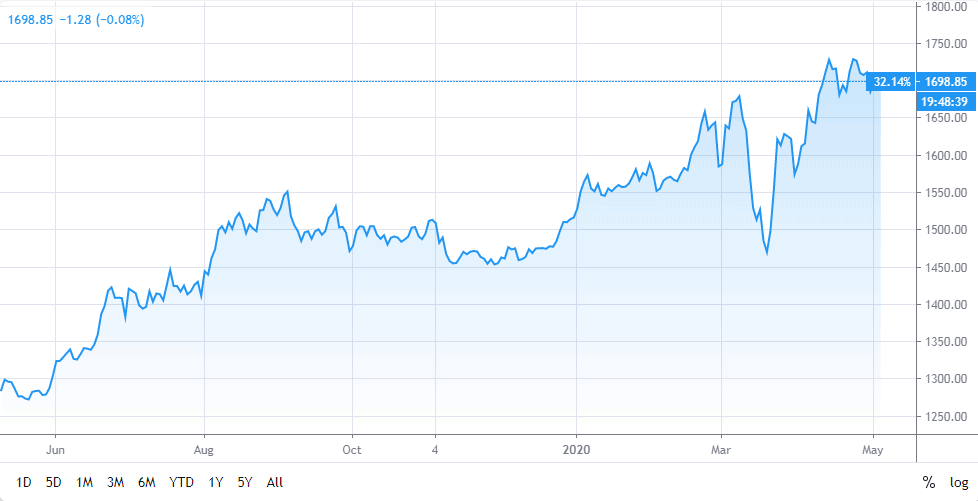Gold, the US dollar and the yen are gaining as traditional ‘safe havens’ while all three of those mentioned above would be exposed in the event of a second wave of coronavirus that will require additional policy actions such as monetization of the deficit or new foreign exchange regulations, said Bloom.
HSBC is backing the US dollar as well as currencies such as the Japanese yen and even the Norwegian krone to perform well amid the coronavirus pandemic.
The UK-listed bank’s head of global foreign exchange strategy David Bloom said it had different plans in the event of L-, U- and V-shaped recoveries, emphasizing that analysts should be prepared for all eventualities. As he warns the global economy is most likely set for a U-shaped recovery with a “jagged bottom” after the coronavirus crisis, which will see several currencies gain as a result.
“It is much more likely that we are in this kind of U with a jagged bottom scenario, and the [US] dollar kind of does well but this is your NOK [Norwegian krone], your yen, your Aussie, your Kiwi,” Bloom told CNBC’s Squawk Box Europe on Monday.
Currencies in countries with strong fiscal positions, such as the dollar and the Japanese yen are expected to benefit from the initial rise in volatility. HSBC is also backing the Norwegian krone, Australian dollar and New Zealand due to their respective governments’ low debt levels.
In a U-shaped scenario, the US and Japanese governments have more room for fiscal stimulus as they continue to try to shore up their economies, and further policies will likely emerge as a key driver of currency movement once the global crisis subsides.
The losers in this scenario, Bloom projected in a research note last week, include the sterling and the Canadian dollar. The fiscal room of both governments is limited, while the euro will likely continue to struggle on the back of stressed finances in Italy and Spain.
While the situation is unlikely to worsen beyond last month’s unprecedented crash in oil price futures to negative $40 and tens of millions of job losses, the assumption of a V-shaped recovery similar to the one that emerged after the financial crisis was optimistic.
Given its recent upward trajectory, gold is looking like a winner at the moment. However, a V-shaped recovery would take away a lot of its power while in other scenarios it will do very well, alongside the Swiss (francs), yen and US dollar. “Those are the defensive currencies to own,” Bloom said, adding that those anticipating a more aggressive V-shape should look to Australia and New Zealand.
In an L-shaped scenario, where low growth, low inflation and low commodity prices foster a prolonged risk-averse market sentiment, foreign exchange trends are likely be driven by external vulnerabilities, Bloom said in the note.
This lends itself well to the yen, due to Japan’s strong international investment position and 30 years’ experience with similar low-growth economy home. The Swiss franc and Norwegian krone also stand to benefit due to “strong external positions,” but Bloom suggested that the real winner in this scenario would be gold.
If you are interested in trading gold you can check a list of our recommended commodity brokes here.
Trusted & Regulated Stock & CFD Brokers
What we like
- 0% Fees on Stocks
- 5000+ Stocks, ETFs and other Markets
- Accepts Paypal Deposits
Min Deposit
$200
Charge per Trade
Zero Commission on real stocks
64 traders signed up today
Visit Now67% of retail investor accounts lose money when trading CFDs with this provider. You should consider whether you can afford to take the high risk of losing your money.
Available Assets
- Total Number of Stocks & Shares5000+
- US Stocks
- German Stocks
- UK Stocks
- European
- ETF Stocks
- IPO
- Funds
- Bonds
- Options
- Futures
- CFDs
- Crypto
Charge per Trade
- FTSE 100 Zero Commission
- NASDAQ Zero Commission
- DAX Zero Commission
- Facebook Zero Commission
- Alphabet Zero Commission
- Tesla Zero Commission
- Apple Zero Commission
- Microsoft Zero Commission
Deposit Method
- Wire Transfer
- Credit Cards
- Bank Account
- Paypall
- Skrill
- Neteller
What we like
- Sign up today and get $5 free
- Fractals Available
- Paypal Available
Min Deposit
$0
Charge per Trade
$1 to $9 PCM
Visit Now
Investing in financial markets carries risk, you have the potential to lose your total investment.
Available Assets
- Total Number of Shares999
- US Stocks
- German Stocks
- UK Stocks
- European Stocks
- EFTs
- IPOs
- Funds
- Bonds
- Options
- Futures
- CFDs
- Crypto
Charge per Trade
- FTSE 100 $1 - $9 per month
- NASDAQ $1 - $9 per month
- DAX $1 - $9 per month
- Facebook $1 - $9 per month
- Alphabet $1 - $9 per month
- Telsa $1 - $9 per month
- Apple $1 - $9 per month
- Microsoft $1 - $9 per month
Deposit Method
- Wire Transfer
- Credit Cards
- Bank Account





